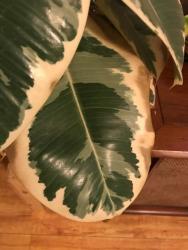WillC said:@cooloutac - Interesting video, but not the final authority. He has an odd definition of indirect sunlight. Unless he is in the southern hemisphere, his south-facing window provides substantial direct sunlight for most of the day, even a couple of feet from the window.
For sure outdoor direct sun would be too intense for all of the Elasticas that were grown under shade for indoor use where light is much less intense.
The dark burgundy Elasticas are just as prone or more so to too much sunlight as the variegated varieties. In any case, I don't think too much sun is a problem for most owners of indoor plants.
I feel the opposite. The teneke are more prone to burn then the burgundy. I would take it a step further then crazy plant guy and say the burgundy actually prefer direct sunlight. I notice they tend to go green or thinner leaved if not getting enough sun. The variegated I would keep in indirect bright light or they tend to burn in from the edges.
If you notice the crazy plant guy has a huge terrace looking window he says is south facing. and his plants are right up against them. They burgundy one looks only inches away. But the teneke one he has way back like 5 feet behind the front plants which are in the path of the light to block it. That one huge windows probably lights up all his plants though, indeed it prolly gets alot of light.
I have burnt all types of plants. Even succulent kinds like snake plants, which supposedly can take direct sun according to the experts, can burn up the whole leaf quite fast. Once you get one little spot, or burnt edges or a scar its best not to face that leaf towards the direct sun or the whole thing can get engulfed before you notice. Even with filtered light with sheer curtains in a north east window this has happened to me. Had a plant for about a year with a little itsy bitsy scar i kept towards the back so you couldn't see it and the plant thrived. Decided one day to rotate it just to change the look. after a week that scar burnt and grew and took up half the leaf and I had to cut it. I also hate crispy looking jagged edges on the snake plants. I now consider them shade plants, even the variegated kind. And like the rubber tree I try not to wet the leaves, just wipe them down when looking dusty or dirty.
The rubber tree I will wipe down quite often. Sometimes a couple times a week. the only plants I mist alot are small or thinner leaf plants. The ones that tend to get brown tips if not getting enough humidity or are prone to spider mites. like palms, dracaenas, ferns, etc...
Most people don't have perfectly south facing and unblocked windows. meaning no buildings or trees, shades etc.. Landscapes and parts of the world are different. So you're right its hard to judge what is direct light from a south window for one persons plant may not be for another.
I actually use led lights for alot of my plants, which I consider better then sun in most cases. And I usually hang the lights right in front of my non south windows. Even in front of the south windows sometimes in the summer.. I live in north east and get quite a bit of cloudy rainy days that can last over a week Either daylight spectrums or red and blues. I have great success with any of them. LED lights are really taking the world by storm right now. They are like magic. Last forever, don't get hot, can take lots of humidity, don't use alot of electricity, I keep them about a foot away and grow plants like crazy. They are teaching kids in school how to grow plants with led's now.


